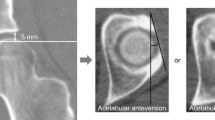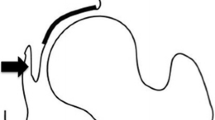Abstract
Background
We believe a curved periacetabular osteotomy is indicated for treatment of severe dysplastic hips with center-edge angles less than 0°, classified as Severin Group IV-b. However, the lower limit of the center-edge angle in hips classified as Severin Group IV-b is not clearly defined to determine which patients should receive periacetabular osteotomy alone.
Questions/purposes
We retrospectively compared the results of curved periacetabular osteotomies performed for the treatment of severe (Severin Group IV-b: center-edge angle < 0°) and moderate (Severin Groups III and IV-a: center-edge angle ≥ 0°) dysplastic hips. We investigated the lower limit of the center-edge angle, which was corrected by a curved periacetabular osteotomy alone in Severin Group IV-b hips.
Patients and Methods
We divided 191 hips in 163 patients into moderate (147 hips) and severe (44 hips) dysplastic hip groups. Minimum followup was 2 years (mean, 70.9 and 70.6 months, respectively). Clinical evaluations were performed using the Harris hip score. Radiographic measurements included the center-edge angle, acetabular head index, acetabular roof obliquity, and head lateralization index. Complications were compared between the two groups.
Results
All clinical and radiographic postoperative parameters showed satisfactory improvement over the preoperative parameters in both groups. The postoperative acetabular roof obliquity and head lateralization index were equivalent between the two groups. Eleven hips deteriorated to end-stage osteoarthritis. No complications were specifically associated with the severe dysplastic hips.
Conclusions
Curved periacetabular osteotomy alone for treatment of severe dysplastic hips with preoperative center-edge angles as low as −20° and classified as Severin Group IV-b restored weightbearing area and medialization.
Level of Evidence
Level III, therapeutic study. See Instructions for Authors for a complete description of the levels of evidence.

Similar content being viewed by others
References
Biedermann R, Donnan L, Gabriel A, Wachter R, Krismer M, Behensky H. Complications and patient satisfaction after periacetabular pelvic osteotomy. Int Orthop. 2008;32:611–617.
Chiari K. Medial displacement osteotomy of the pelvis. Clin Orthop Relat Res. 1974;98:55–71.
Clohisy JC, Barrett SE, Gordon JE, Delgado ED, Schoenecker PL. Periacetabular osteotomy for the treatment of severe acetabular dysplasia. J Bone Joint Surg Am. 2005;87:254–259.
Clohisy JC, Barrett SE, Gordon JE, Delgado ED, Schoenecker PL. Periacetabular osteotomy in the treatment of severe acetabular dysplasia: surgical technique. J Bone Joint Surg Am. 2006;88(suppl 1):65–83.
Davey JP, Santore RF. Complications of periacetabular osteotomy. Clin Orthop Relat Res. 1999;363:33–37.
Espinosa N, Strassberg J, Belzile EL, Millis MB, Kim YJ. Extraarticular fractures after periacetabular osteotomy. Clin Orthop Relat Res. 2008;466:1645–1651.
Ganz R, Klaue K, Vinh TS, Mast JW. A new periacetabular osteotomy for the treatment of hip dysplasias: technique and preliminary results. Clin Orthop Relat Res. 1988;232:26–36.
Harris WH. Traumatic arthritis of the hip after dislocation and acetabular fractures: treatment by mold arthroplasty. An end-result study using a new method of result evaluation. J Bone Joint Surg Am. 1969;51:737–755.
Heyman CH, Herndon CH. Legg-Perthes disease: a method for the measurement of the roentgenographic result. J Bone Joint Surg Am. 1950;32:767–778.
Hussell JG, Mast JW, Mayo KA, Howie DW, Ganz R. A comparison of different surgical approaches for the periacetabular osteotomy. Clin Orthop Relat Res. 1999;363:64–72.
Ito H, Matsuno T, Minami A. Rotational acetabular osteotomy through an Ollier lateral U approach. Clin Orthop Relat Res. 2007;459:200–206.
Massie WK, Howorth MB. Congenital dislocation of the hip. Part I: Method of grading results. J Bone Joint Surg Am. 1950;32:519–531.
Matta JM, Stover MD, Siebenrock K. Periacetabular osteotomy through the Smith-Petersen approach. Clin Orthop Relat Res. 1999;363:21–32.
Murphy SB, Millis MB. Periacetabular osteotomy without abductor dissection using direct anterior exposure. Clin Orthop Relat Res. 1999;364:92–98.
Naito M, Shiramizu K, Akiyoshi Y, Ezoe M, Nakamura Y. Curved periacetabular osteotomy for treatment of dysplastic hip. Clin Orthop Relat Res. 2005;433:129–135.
Ninomiya S. Rotational acetabular osteotomy for the severely dysplastic hip in the adolescent and adult. Clin Orthop Relat Res. 1989;247:127–137.
Nozawa M, Shitoto K, Hirose T, Matsuda K, Michino K, Kajihara H, Maezawa K, Kurosawa H. Rotational acetabular osteotomy for severely dysplastic acetabulum. Arch Orthop Trauma Surg. 2000;120:376–379.
Severin E. Contribution to the knowledge of congenital dislocation of the hip joint: late results of closed reduction and arthrographic studies of recent cases. Acta Chir Scand. 1941;84(suppl 63):37–54.
Shindo H, Igarashi H, Taneda H, Azuma H. Rotational acetabular osteotomy for severe dysplasia of the hip with a false acetabulum. J Bone Joint Surg Br. 1996;78:871–877.
Siebenrock KA, Schöll E, Lottenbach M, Ganz R. Bernese periacetabular osteotomy. Clin Orthop Relat Res. 1999;363:9–20.
Teratani T, Naito M, Shiramizu K, Nakamura Y, Moriyama S. Modified pubic osteotomy for medialization of the femoral head in periacetabular osteotomy: a retrospective study of 144 hips. Acta Orthop. 2008;79:474–482.
Tönnis D. Clinical and radiographic schemes for evaluating therapeutic results, Chapter 13. In: Congenital Dysplasia and Dislocation of the Hip in Children and Adults. New York, NY: Springer-Verlag; 1987:165–171.
Ward WT, Vogt M, Grudziak JS, Tumer Y, Cook PC, Fitch RD. Severin classification system for evaluation of the results of operative treatment of congenital dislocation of the hip: a study of intraobserver and interobserver reliability. J Bone Joint Surg Am. 1997;79:656–663.
Wiberg G. Studies on dysplastic acetabula and congenital subluxation of the hip joint: with special reference to the complication of osteoarthritis. Acta Chir Scand. 1939;83(suppl 58):7–38.
Yasunaga Y, Takahashi K, Ochi M, Ikuta Y, Hisatome T, Nakashiro J, Yamamoto S. Rotational acetabular osteotomy in patients forty-six years of age or older: comparison with younger patients. J Bone Joint Surg Am. 2003;85:266–272.
Acknowledgments
We thank Dr. Takeshi Teratani and Dr. Akinori Takeyama for their invaluable advice during the course of this study.
Author information
Authors and Affiliations
Corresponding author
Additional information
Each author certifies that he/she has no commercial associations (eg, consultancies, stock ownership, equity interest, patient/licensing arrangements, etc) that might pose a conflict of interest in connection with the submitted article.
Each author certifies that his or her institution approved the human protocol for this investigation, that all investigations were conducted in conformity with ethical principles of research, and that informed consent for participation in the study was obtained
About this article
Cite this article
Karashima, H., Naito, M., Shiramizu, K. et al. A Periacetabular Osteotomy for the Treatment of Severe Dysplastic Hips. Clin Orthop Relat Res 469, 1436–1441 (2011). https://doi.org/10.1007/s11999-010-1616-x
Received:
Accepted:
Published:
Issue Date:
DOI: https://doi.org/10.1007/s11999-010-1616-x




